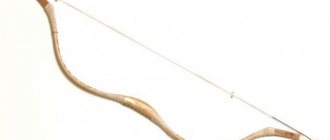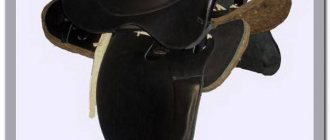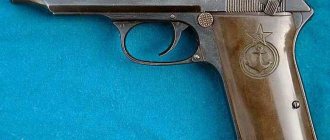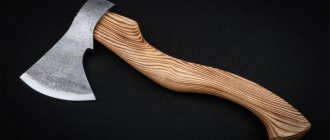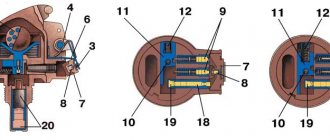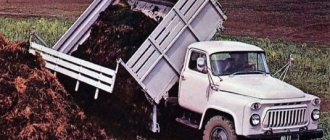Two-handed sword
Many stories, epics, legends and inventions of people were created around the weapons of the Middle Ages. So the two-handed sword is shrouded in secrets and allegories. People have always had doubts about the huge size of the sword. After all, for combat, what is primarily important is not the size, but the efficiency and combat power of the weapon. Despite its size, the sword was a success and was very popular among warriors. But only strong, powerful warriors could use such a sword. The total weight of this specimen of the sword is about two kilograms, five hundred grams, the length is about a meter, and the handle is a quarter of a meter.
Historical facts
A two-handed sword of this type became widespread in battles of the Middle Ages in quite late times. All the warrior’s equipment consisted of metal armor and a shield for protection from enemy attacks, a sword and a spear. Gradually, craftsmen learned to cast metal weapons with better quality, and new types of swords appeared, compact in size and much more effective.
Such weapons were expensive; not every soldier could afford to purchase a sword. The sword was wielded by the most dexterous, brave, courageous and fairly wealthy warriors and guards. The experience of wielding a sword was passed on from father to son, constantly improving skills. The warrior had to have heroic strength, excellent reaction, and masterfully wield a sword.
History of appearance
Claymores came into use as weapons in the Middle Ages. At the end of the 14th century, Scottish two-handers were still rarely used, but in the 16th century it became a typical weapon of the Highlanders or Highlanders - foot warriors of the North Scottish Highlands. Their clans fought among themselves and with the British. The graves of warriors were decorated with slabs with images of blades.
The predecessors of Scottish weapons were knight's swords. As it developed, the claymore acquired European features and a hook for parrying enemy blows. This is how the Spanish espadon and the German zweihander appeared.
Gradually, bladed weapons began to be replaced with firearms. By the beginning of the 18th century, rare warriors wore claymores. The weapon was revered as noble only by the Scottish nobility. The swords were kept for several generations. The claymore was considered a relic, a symbol of military glory and valor of the ancestors.
The purpose of a two-handed sword
One of the two-handed swords
Due to its huge dimensions and heavy weight, only soldiers of heroic physique wielded a two-handed sword. In close battles they were very often used in the front ranks to break through the first ranks of the enemy. To deprive the shooters and soldiers with halberds coming behind them of the opportunity to strike. Since the dimensions of the sword required a certain free perimeter for the warrior to swing, close combat tactics had to be changed periodically. The soldiers were forced to constantly change their location; in the center of the battle, due to the large concentration of soldiers, it was very difficult for them to fight.
When conducting close combat, swords were used mainly to deliver a crushing blow and break through the enemy’s defenses. In battles in open areas, soldiers used a sword to strike their opponents from above and below in battle. The handle of the sword could be struck in the face of the enemy in maximum proximity to each other.
Using a Claymore
Scottish two-handed weapons are slashing weapons. By the characteristic appearance of the sword, mercenaries, bodyguards, guards and soldiers of special forces were recognized. German soldiers received double pay for mastering the technique of fighting with claymores.
To swing and maneuver a Scottish sword, you need a lot of space. Therefore, it was rarely used in service. Claymore was used in single combat:
- kept the enemy at a distance of 1.5-2 meters;
- dispersed the crowd to make way for a high-ranking person;
- fought with foot and horse soldiers;
- made their way through the enemy's ranks;
- defended the fortress walls;
- covered the military leaders.
The striking power of a claymore is equal to that of an axe. The heavy sword pierced armor and broke shields. Scottish weapons were adopted by elite infantry units. They walked ahead of the army, cut down the enemy's peaks and destroyed the first ranks of the enemies.
Design Features
There were several types of two-handed swords:
- At military ceremonies, for various rituals, and as a gift for rich, noble people, large two-handed swords were most often used; the weight of each such specimen reached five kilograms. Some individual specimens were very often used as a special simulator for improving combat skills and hand training.
- A two-handed sword for combat weighing about three and a half kilograms and had a length of about one meter and seventy centimeters. The length of the handle of such specimens was about half a meter and served as a balancer for the sword. The soldier, who was fluent in combat tactics and had excellent dexterity and dexterity, practically did not notice the size of the sword. For comparison, it is worth noting that the total weight of a one-handed sword was about one and a half kilograms.
- A classic two-handed sword with a length from the floor to the soldier's shoulder, and a hilt from the wrist to the elbow.
Characteristics table
| Hardening | Attack parameters | Stat Bonuses | |||||||||||
| Ordinary | 307 | — | — | — | — | — | — | S | D | — | — | — | — |
| Normal +5 | 430 | — | — | — | — | — | — | S | D | — | — | — | — |
| Magic | 193 | 236 | — | — | — | — | — | B | E | C | — | — | — |
| Magic +5 | 270 | 331 | — | — | — | — | — | B | E | B | — | — | — |
| Fire | 193 | — | 236 | — | — | — | — | B | E | — | C | — | — |
| Fire +5 | 270 | — | 331 | — | — | — | — | B | E | — | B | — | — |
| Lightning | 193 | — | — | 236 | — | — | — | B | E | — | — | C | — |
| Lightning +5 | 270 | — | — | 331 | — | — | — | B | E | — | — | B | — |
| Dark | 193 | — | — | — | 236 | — | — | B | E | — | — | — | B |
| Darkness +5 | 270 | — | — | — | 331 | — | — | B | E | — | — | — | B |
| I | 193 | — | — | — | — | 123 | — | B | E | — | — | — | — |
| Poison +5 | 270 | — | — | — | — | 154 | — | B | E | — | — | — | — |
| Bleeding | 193 | — | — | — | — | — | 123 | B | E | — | — | — | — |
| Bleed+5 | 270 | — | — | — | — | — | 154 | B | E | — | — | — | — |
| Rough | 353 | — | — | — | — | — | — | D | E | — | — | — | — |
| Rough +5 | 494 | — | — | — | — | — | — | D | E | — | — | — | — |
| Enchantment | 307 | — | — | — | — | — | — | C | E | D | — | — | — |
| Enchantment +5 | 430 | — | — | — | — | — | — | C | E | C | — | — | — |
| Simplicity | 153 | — | — | — | — | — | — | C | E | — | — | — | — |
| Simplicity +5 | 215 | — | — | — | — | — | — | C | E | — | — | — | — |
Positive and negative qualities of the sword
If we consider the advantages of two-handed swords, we can highlight the most basic ones:
- A warrior using this sword was protected around a fairly large perimeter;
- Crushing slashes delivered with a two-handed sword are very difficult to parry;
- The sword is universal in use.
It is worth paying attention to the negative qualities:
- The sword had to be held with both hands, therefore, the possibility of additional protection in the form of a shield was excluded.
- The dimensions of the sword did not allow for quick movement, and the heavy weight led to rapid fatigue of the warrior and, as a result, to low effectiveness in battle.
How to survive in Dark Souls 2?
This is one of the most challenging games that will surely please all the hardcore gamers. Deadly traps, dangerous enemies, ferocious monsters - it's all there in Dark Souls 2. Weapons are the only thing that can save you from death. Therefore, in order to survive, you first need to acquire powerful weapons.
We will talk about equipment in Dark Souls 2. Rings, weapons, other equipment - we will discuss all this in this article. Want to know what the most powerful weapon in the game is? Read on.
Types of two-handed swords
Claymore
- Claymore. Compact Scottish weapons, among the various examples of two-handed swords, are distinguished by their relatively small dimensions. The length of the blade was about one hundred and ten centimeters. Another important distinctive feature of this sample is the special design, thanks to which a warrior could pull any weapon out of the enemy’s hands. The small size of the sword allows it to be used most effectively in combat battles; it is rightfully considered the best example among two-handed swords.
- Zweihander. This sample is distinguished by its enormous dimensions; the length of the sword reaches two meters. The design of the sword is very specific; the paired crosspiece (guard) serves as the boundary between the double-edged blade, the hilt and the unsharpened part of the sword. Such an instance was used in battle to crush the enemy armed with spears and halberds.
- Flamberge. A type of two-handed sword with a special wave-shaped blade. Thanks to such an unusual design, the effectiveness of a soldier armed with such a sword in combat battles has increased many times over. A warrior wounded by such a blade took a long time to recover, the wounds healed very poorly. Many military leaders executed captured soldiers for wearing such a sword.
A little about other types of swords.
- Cavalrymen often used the Estok sword to pierce through the enemy’s armor. The length of this specimen is one meter and thirty centimeters.
- The next classic type of two-handed sword. “Espadon” is one hundred and eighty centimeters long. It has a crosspiece (guard) of two arms. The center of gravity of such a blade is shifted to the tip of the sword blade.
- Sword "Katana". A Japanese copy of the sword, with a curved blade. Used by soldiers mainly in close combat, the length of the blade is about ninety centimeters, the handle is about thirty centimeters. Among the swords of this variety, there is a sample with a length of two hundred and twenty-five centimeters. The power of this sword allows you to cut a person into two parts with one blow.
- Chinese two-handed sword "Dadao". A distinctive feature is a wide blade, curved, sharpened on one side. Such a sword found its use even during the war with Germany in the forties of the twentieth century. Soldiers used the sword in hand-to-hand combat with the enemy.
Dark Souls 2 - the secret of popularity
Many players are interested in questions like: “Why is Dark Souls 2 so popular?” The answer is quite simple. Just look at the modern gaming industry. Games have become more casual. Stupid enemies, first aid kits at every step and saves every five meters. None of this happened before. The games of the 80s and 90s were very difficult, and to beat them you had to have perseverance and incredible patience. Previously, passing the game was a real test that only the strongest could withstand. Now many game makers have forgotten about this. Many, but not all. There are still those companies that understand that a game should challenge gamers and be difficult. From Software is one of them.
The guys from From Software have created an incredible project called Dark Souls 2. Do you think the old Battletoads is the most difficult game? It means you just haven't played Dark Souls 2. Compared to From Software's brainchild, the adventures of the fighting toads are baby talk. Do you doubt this? Then play Dark Souls 2 and see for yourself.
In the world of Dark Souls 2, weapons are your only companion and companion throughout many hours of gameplay. Let's look at what types of weapons there are in the game, what their features are, etc.
Interesting Facts
The largest two-handed sword
In one of the historical museums in Holland, a two-handed sword is exhibited, preserved in excellent condition to this day. This is a huge specimen with a length of two meters and fifteen centimeters and a weight of six kilograms and six hundred grams. Historians suggest that the sword was made in the fifteenth century in Germany. The sword was not used in military battles; it served as a festive attribute for various military holidays and ceremonies. When making the handle of the sword, oak was used as a material and decorated with a piece of goat skin.
Where did they forge?
The Scots made their own swords from scrap materials. The arms of the handle were made from a rod bent in half with pointed ends. After the spread of highlander weapons in Europe, blades began to be made in Germany. Stamps on ancient two-handed swords indicate forges in Solingen, Passau, Luneburg.
The hilts were made in Scotland, on the island of Islay. Edinburgh also became famous for its skillful blades.
It is believed that aristocratic warriors could afford edged weapons, since blacksmiths valued their skills dearly. Claymores were also made to order and decorated with family symbols and engravings.
Estoc
Estoc (French estoc) is a two-handed piercing weapon designed to pierce knightly armor. A long (up to 1.3 meters) tetrahedral blade usually had a stiffening rib. If previous swords were used as a means of countermeasures against cavalry, then the estok, on the contrary, was the weapon of the horseman. Riders wore it on the right side of the saddle so that in case of loss of the pike they would have an additional means of self-defense. In horse fighting, the sword was held with one hand, and the blow was delivered due to the speed and mass of the horse. In a foot skirmish, the warrior took it in both hands, compensating for the lack of mass with his own strength. Some examples of the 16th century have a complex guard, like a sword, but most often there was no need for it. Tags: interesting • history • sword • weapons • Middle Ages • uniform


